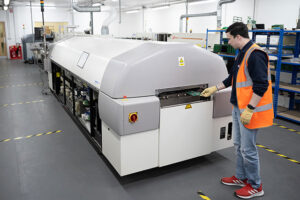 With more than a year gone since the UK first went into lockdown, David O’Keeffe, General Manager at Trojan Electronics, examines the impact the pandemic has had on contract electronics manufacturing (CEM) and asks: Has the way customers buy components and assembled electronic goods changed indelibly?
With more than a year gone since the UK first went into lockdown, David O’Keeffe, General Manager at Trojan Electronics, examines the impact the pandemic has had on contract electronics manufacturing (CEM) and asks: Has the way customers buy components and assembled electronic goods changed indelibly?
“It is clear that the past year has had a significant impact on customer demand,” O’Keeffe commented.
“Whilst the electronics industry initially appeared frozen in a kind of suspended animation, those OEM manufacturers that could diversify or increase production, did so rapidly and impressively.”
Understandably this placed additional pressure on an already fragile supply chain.
O’Keeffe explained: “Brexit, tariff changes between the US and China, etc. all meant that the supply chain was already under pressure.
“Add to that confirmed Covid cases almost everywhere and contract electronics manufacturers were now facing not just major operational, but component supply issues.”
 O’Keeffe said that Trojan Electronics was already agreeing and adhering to production and delivery schedules with its OEM customers.
O’Keeffe said that Trojan Electronics was already agreeing and adhering to production and delivery schedules with its OEM customers.
“At Trojan our aim has always been to deliver on time, every time. This past year however, we have been asked time and time again to provide delivery guarantees before contracts could even be finalised.”
Although this hardly seems surprising given that the average delivery times were three or more weeks longer than usual within the industry generally, O’Keeffe said this was a definitive change in customer behaviour.
At the same time many industry managers predicted that the industry would only start to recover by the third quarter of 2021.
O’Keeffe believed this made the need for controlling costs and greater flexibility within the supply chain more important than ever.
“Whilst flexibility was already one of our core values, the scarcity of semi-conductors made this quite challenging.
“For some, one could imagine the appeal of grey market components, but this would then raise quality and traceability concerns – something we were very careful – and would recommend others – to avoid.”

O’Keeffe said Trojan Electronics currently experienced a reject rate of less than 210 parts per million, something the company was very proud of.
“At Trojan Electronics, every customer relationship is personal, driven around quality, flexibility and delivery.
“Our ability to deliver on time, every time is closely linked to our focus on quality. This means sourcing, assembling and shipping the right components first time, every time too.
“However, there were clear bottlenecks within the supply chain making this quite challenging overall.”
In addition to delivery guarantees, existing customers were also asking for quicker deliveries according to O’Keeffe.
“Whilst we regularly flex to meet customer demand, this now appeared to be a critical aspect for not only winning, but retaining, customers,” added O’Keeffe.
“Within the wider industry we were aware of stock being available, but almost impossible to procure in time.”
On the other side of the coin, a large-scale return to the UK for electronics manufacturing was one of the most positive effects from Covid-19 according to O’Keeffe.
“The UK electronics industry remains one of the most important drivers for the UK economy. Any negative effects on the industry which prevents or slows down its ability to supply goods such as healthcare device or consumer goods, will also have a significant impact on the wider economy.”
In the UK, electronics manufacturing accounted for £8.4bn of GVA (Gross-Vale-Added) in 2018 despite making up only 5% of the UK manufacturing industry.
In 2020, the electronics component market declined by 10% as a result of Covid-19. However, demand had already slowed in the last quarter of 2019 as a consequence of the China vs. US situation meaning lots of customers could get rid of excess inventory.
As lead-times increased, this trend was reversed and many suppliers increased their in-house stockholding to counteract possible product shortages.
“When looking at the Electronic Components Supply Network (ecsn) numbers, 2020 ended with a nine per cent fall in sales revenue overall. Given how surreal and economically challenging the past year has been, this is actually pretty remarkable,” said O’Keeffe.
In predicting whether these trends will continue, O’Keeffe added: “Without a magic ball, this is not an easy call. However, we are anticipating:
- longer overall lead-times to remain;
- more emphasis of delivery guarantees as part of the procurement process
- more focus on quality rather than price.”
A large-scale return to UK manufacturing should help maintain production lead-times, provide greater overall traceability and result in better quality-controlled products and overall industry collaboration. In providing the delivery guarantees customers are looking for, this unified approach should continue to make a positive impact amidst very challenging times.
According to Make UK, UK manufacturing:
- employs 2.7 million people – earning an average of £32,500
- contributes 11% of GVA
- accounts for 45% of total exports – totalling £275bn
- represents 69% of business research and development (R&D)
- provides 13% of business investment

Contact Trojan Electronics
Phone: +44 (0)1792 469020
 CIE Components in Electronics
CIE Components in Electronics

